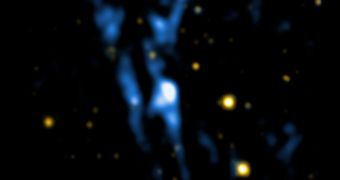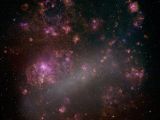By using the Chandra X-ray Space Observatory and the XMM-Newton Space Observatory, astronomers were able to observe a light echo originating from a supernova explosion in the Large Magellanic Cloud, which was first observable from Earth nearly 400 years ago. The supernova remnant, dubbed SNR 0509-67.5, lies 160,000 light years away, meaning that it actually exploded more than 160,400 years ago.
"We have a chance here to see the supernova in both the past and the present. We can see light from the blast bouncing off of dust, and we can also see the supernova remnants. It's kind of like having a time machine," said Harvard University astronomer, Armin Rest.
According to Rest, supernova remnants such as the SNR 0509-67.5 will be visible for observations for some time; however, they are extremely difficult to study directly from such a huge distance. Additionally, not much is known about the types of stars determining the creation of supernova remnants.
"Unless you record light directly from a supernova when it happens, you get second-hand information like at a crime scene. Just like it's hard to identify the killer, it's difficult to determine the type of supernova explosion. We've recorded only a few supernovae in the past couple of thousand years," explains Rest.
Observing a supernova explosion while it takes place would be an ideal occasion to study the phenomenon, but they fade away back into darkness extremely fast, leaving astronomers with very little time to make a detailed analysis.
This is why light echoes represent such an important tool for observing supernova explosions. Practically, in an ideal configuration, one would be able to see the 'replay' of the event over and over again. After nearly five years of study, Rest's team has even been able to construct a video of the event, based on the data collected from the light echoes.
"As the light spreads out from the blast, interstellar gas and dust reflect it around the universe. In this case, it took a longer path to get to Earth than the direct light," says Rest. Even though, the explosion occurred some four centuries ago, the reflected light is comparable to that of the original blast.
"Everything about the light is preserved, so we can analyze the spectrum and pinpoint the supernova type, including what kind of elements it produced. Our ability to see light echoes is improving every year now. We can compare these light echoes to their supernova remnants and also better estimate how far away they are. Distance is one of the hardest things to determine in astronomy," concluded Rest.

 14 DAY TRIAL //
14 DAY TRIAL // 
